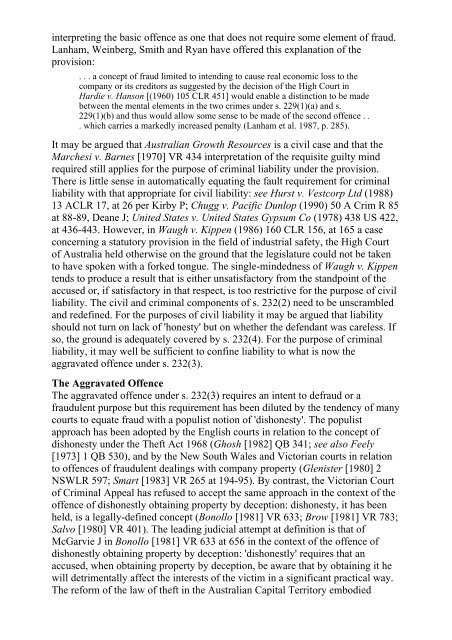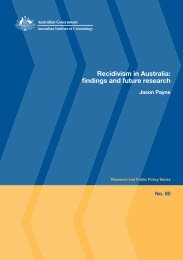Fraud and the liability of company directors - Australian Institute of ...
Fraud and the liability of company directors - Australian Institute of ...
Fraud and the liability of company directors - Australian Institute of ...
You also want an ePaper? Increase the reach of your titles
YUMPU automatically turns print PDFs into web optimized ePapers that Google loves.
interpreting <strong>the</strong> basic <strong>of</strong>fence as one that does not require some element <strong>of</strong> fraud.<br />
Lanham, Weinberg, Smith <strong>and</strong> Ryan have <strong>of</strong>fered this explanation <strong>of</strong> <strong>the</strong><br />
provision:<br />
. . . a concept <strong>of</strong> fraud limited to intending to cause real economic loss to <strong>the</strong><br />
<strong>company</strong> or its creditors as suggested by <strong>the</strong> decision <strong>of</strong> <strong>the</strong> High Court in<br />
Hardie v. Hanson [(1960) 105 CLR 451] would enable a distinction to be made<br />
between <strong>the</strong> mental elements in <strong>the</strong> two crimes under s. 229(1)(a) <strong>and</strong> s.<br />
229(1)(b) <strong>and</strong> thus would allow some sense to be made <strong>of</strong> <strong>the</strong> second <strong>of</strong>fence . .<br />
. which carries a markedly increased penalty (Lanham et al. 1987, p. 285).<br />
It may be argued that <strong>Australian</strong> Growth Resources is a civil case <strong>and</strong> that <strong>the</strong><br />
Marchesi v. Barnes [1970] VR 434 interpretation <strong>of</strong> <strong>the</strong> requisite guilty mind<br />
required still applies for <strong>the</strong> purpose <strong>of</strong> criminal <strong>liability</strong> under <strong>the</strong> provision.<br />
There is little sense in automatically equating <strong>the</strong> fault requirement for criminal<br />
<strong>liability</strong> with that appropriate for civil <strong>liability</strong>: see Hurst v. Vestcorp Ltd (1988)<br />
13 ACLR 17, at 26 per Kirby P; Chugg v. Pacific Dunlop (1990) 50 A Crim R 85<br />
at 88-89, Deane J; United States v. United States Gypsum Co (1978) 438 US 422,<br />
at 436-443. However, in Waugh v. Kippen (1986) 160 CLR 156, at 165 a case<br />
concerning a statutory provision in <strong>the</strong> field <strong>of</strong> industrial safety, <strong>the</strong> High Court<br />
<strong>of</strong> Australia held o<strong>the</strong>rwise on <strong>the</strong> ground that <strong>the</strong> legislature could not be taken<br />
to have spoken with a forked tongue. The single-mindedness <strong>of</strong> Waugh v. Kippen<br />
tends to produce a result that is ei<strong>the</strong>r unsatisfactory from <strong>the</strong> st<strong>and</strong>point <strong>of</strong> <strong>the</strong><br />
accused or, if satisfactory in that respect, is too restrictive for <strong>the</strong> purpose <strong>of</strong> civil<br />
<strong>liability</strong>. The civil <strong>and</strong> criminal components <strong>of</strong> s. 232(2) need to be unscrambled<br />
<strong>and</strong> redefined. For <strong>the</strong> purposes <strong>of</strong> civil <strong>liability</strong> it may be argued that <strong>liability</strong><br />
should not turn on lack <strong>of</strong> 'honesty' but on whe<strong>the</strong>r <strong>the</strong> defendant was careless. If<br />
so, <strong>the</strong> ground is adequately covered by s. 232(4). For <strong>the</strong> purpose <strong>of</strong> criminal<br />
<strong>liability</strong>, it may well be sufficient to confine <strong>liability</strong> to what is now <strong>the</strong><br />
aggravated <strong>of</strong>fence under s. 232(3).<br />
The Aggravated Offence<br />
The aggravated <strong>of</strong>fence under s. 232(3) requires an intent to defraud or a<br />
fraudulent purpose but this requirement has been diluted by <strong>the</strong> tendency <strong>of</strong> many<br />
courts to equate fraud with a populist notion <strong>of</strong> 'dishonesty'. The populist<br />
approach has been adopted by <strong>the</strong> English courts in relation to <strong>the</strong> concept <strong>of</strong><br />
dishonesty under <strong>the</strong> Theft Act 1968 (Ghosh [1982] QB 341; see also Feely<br />
[1973] 1 QB 530), <strong>and</strong> by <strong>the</strong> New South Wales <strong>and</strong> Victorian courts in relation<br />
to <strong>of</strong>fences <strong>of</strong> fraudulent dealings with <strong>company</strong> property (Glenister [1980] 2<br />
NSWLR 597; Smart [1983] VR 265 at 194-95). By contrast, <strong>the</strong> Victorian Court<br />
<strong>of</strong> Criminal Appeal has refused to accept <strong>the</strong> same approach in <strong>the</strong> context <strong>of</strong> <strong>the</strong><br />
<strong>of</strong>fence <strong>of</strong> dishonestly obtaining property by deception: dishonesty, it has been<br />
held, is a legally-defined concept (Bonollo [1981] VR 633; Brow [1981] VR 783;<br />
Salvo [1980] VR 401). The leading judicial attempt at definition is that <strong>of</strong><br />
McGarvie J in Bonollo [1981] VR 633 at 656 in <strong>the</strong> context <strong>of</strong> <strong>the</strong> <strong>of</strong>fence <strong>of</strong><br />
dishonestly obtaining property by deception: 'dishonestly' requires that an<br />
accused, when obtaining property by deception, be aware that by obtaining it he<br />
will detrimentally affect <strong>the</strong> interests <strong>of</strong> <strong>the</strong> victim in a significant practical way.<br />
The reform <strong>of</strong> <strong>the</strong> law <strong>of</strong> <strong>the</strong>ft in <strong>the</strong> <strong>Australian</strong> Capital Territory embodied















